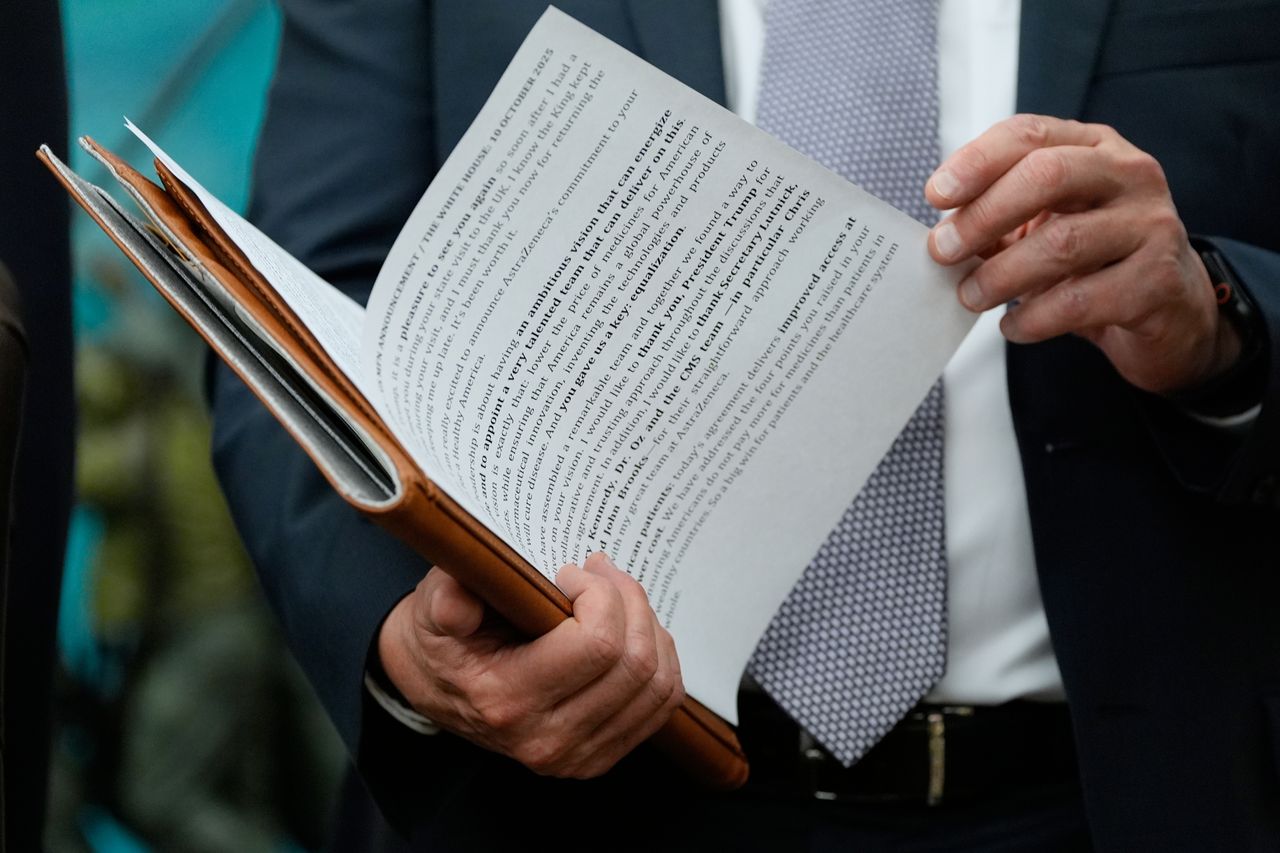| |  | | | | |  | By Megan R. Wilson | - Continued stalemate: Congress appears no closer to a budget deal to end the government shutdown as Republican leadership stands firm in rejecting the inclusion of an Obamacare subsidy extension.
- Public health cuts: More than 1,200 positions at the Department of Health and Human Services could get the ax in layoffs the Trump administration is pinning on the government shutdown, culling people at agencies handling public health and mental health issues.
- Drug deal déjà vu: AstraZeneca becomes the latest pharma giant to strike a pricing deal with the administration, mirroring the one with Pfizer that came before it.
Good afternoon and welcome to the Health Brief newsletter. I’m Megan Wilson, your health policy host. If you’ve got the holiday off today, I hope it’s a relaxing one for you. Do you have any tips, scoops or intel? Let’s chat. You can reach me at megan.wilson@washpost.com or on Signal at megan.434. This newsletter is published by WP Intelligence, The Washington Post’s subscription service for professionals that provides business, policy and thought leaders with actionable insights. WP Intelligence operates independently from the Washington Post newsroom. Learn more about WP Intelligence. | | | |  | The Lead Brief | As we enter the third week of this partial government shutdown, it’s clear that Congress still isn’t functioning. The Senate is back in session tomorrow, but — even so — there doesn’t appear to be a path forward to reopening the federal government in the near term. Some Senate committees had previously been holding hearings on policy issues, including other areas of health care policy, but it’s tumbleweeds on the public congressional calendar so far. In the House, Speaker Mike Johnson (R-Louisiana) plans to keep the chamber in recess until next week. He spoke to reporters earlier today, providing a look into how difficult it may be to crawl out of the budget impasse. Asked whether he wanted to repeal and replace Obamacare, Johnson gave a roughly five-minute answer that noted Republicans’ last failed attempt in 2017: “I still have PTSD from the experience,” he said. “Can we completely repeal and replace Obamacare? Many of us are skeptical about that now because the roots are so deep.” “We have to fix health care in America, and we have ideas to do it. But we have to have the government open and operating to do that; I cannot snap my fingers and go into a back room with [Senate Minority Leader] Chuck Schumer and go, ‘Oh, here’s a magic fix for it.’ It’s not how it’s going to work,” Johnson said. There are “probably 100 ideas on the table to fix it, but we can’t do that overnight; it will take October and probably part of November to get the consensus built around that. It is impossible and inappropriate for Democrats to demand … that it should be part of the negotiation today for a simple continuing resolution,” he said. “That is not a deliverable, and they know it.” | | | |  | Executive Health Brief | The Trump administration is cutting more than 1,200 people from the Department of Health and Human Services as part of more than 4,000 government-wide layoffs it’s blaming on the shutdown. → More than 1,000 employees at the Centers for Disease Control and Prevention are receiving RIF notices, reports my colleague Lena H. Sun in the Washington Post newsroom. She spoke with multiple people who’d received the notices and others with direct knowledge of the cuts. → Read Lena’s story that details the inner-workings of the layoffs and the effort to reverse some of them. Shortly after the figures were reported, the administration said that some had sent some notices in error and would be reversed, but it’s not yet clear how many. Some of the people whose jobs would be restored include those leading the measles response in the U.S. and abroad, staff responding to an Ebola outbreak, CDC’s global health leadership and some CDC disease detectives. But the Atlanta-based agency is still likely losing key staff that help monitor and respond to deadly disease outbreaks — including about 20 officials from the Center for Forecasting and Outbreak Analytics, the office that helps predict the illnesses that will occur during the fall and winter respiratory disease season so that public health officials can best respond to them. It’s also reportedly losing staff in its Washington office, which handles congressional inquiries, suicide researchers working in CDC’s National Center for Injury Prevention and Control, and several other obscure-yet-important offices meant to help the agency run and keep its employees safe. → The administration told Lena that the sweeping cuts are meant to rein in growth of the agency during the Biden administration’s pandemic response. “All HHS employees receiving reduction-in-force notices were designated non-essential by their respective divisions,” HHS spokesman Andrew Nixon said. “HHS continues to close wasteful and duplicative entities, including those that are at odds with the Trump administration’s Make America Healthy Again agenda.” → The Substance Abuse and Mental Health Services Administration, or SAMHSA, received RIF notices for more than 100 employees, NPR first reported. The agency, created by bipartisan legislation in 1992, had already suffered layoffs earlier this year as part of the administration’s larger reorganization. It’s now reportedly half its former size, based on NPR estimates. The agency runs the 988 suicide prevention hotline, and awards grants to help fund programs nationwide, including ones aiming to curb and treat substance abuse issues. Health agencies are already reeling from the massive restructuring the Trump administration has made throughout HHS this year that resulted in roughly 10,000 employees being laid off. → Politico reported last week that those struggles are increasing for SAMHSA as some of its top officials have been reassigned on temporary details to assist chronically under-resourced Indian Health Service clinics. |  | | AstraZeneca CEO Pascal Soriot checks his notes before speaking at a drug pricing event President Donald Trump in the Oval Office on Friday. (Alex Brandon/AP) | | | |  | Industry Rx | If you watched the AstraZeneca drug pricing announcement in the Oval Office and it all felt somewhat familiar, you’d be totally justified in your déjà vu. The deal appears roughly identical to the deal the administration made with Pfizer less than two weeks earlier. The Trump administration has been focused on lowering drug prices for Americans by urging drug companies to match their prices with the prices other wealthy countries pay for medicines, known as “most favored nation” pricing. AstraZeneca, like Pfizer, agreed to offer MFN pricing on the drugs it sells directly to consumers, on any new medicines and some of the products purchased by the Medicaid program for lower-income Americans. The company received three years of tariff relief in exchange for its pledge to invest $50 billion in its U.S. capabilities. I dug through some public data, so let’s go through what we know about the company and its deal and what is still unclear: - Although securing tariff relief was part of the deal, many of the medicines it sells in the U.S. are already made here. The company has 11 manufacturing sites in the U.S. already — in California, Delaware, Georgia, Indiana, Maryland, Pennsylvania, Puerto Rico and Texas.
- It appears as if the company doesn’t have massive exposure to the Medicaid marketplace. I dove into Medicaid data and found that AstraZeneca has just two products that are among the program’s top 100 most costly drugs: Symbicort, an inhaler medication to treat chronic obstructive pulmonary disease (COPD) and asthma, and Farxiga, a medicine used to treat diabetes and chronic kidney disease.
- The products involved are part of a confidential agreement with the administration, so it’s not clear which ones will be sold to Medicaid at the MFN discount. The law requires drugmakers to discount medicines sold to the Medicaid program, but this deal seeks to bring those prices lower.
- For consumers, the math can be even tricker. The administration is advertising a couple of AstraZeneca inhalers directly to consumers at discounts near 100 percent. A third type of inhaler made by the company, a fact sheet says, will be “654 percent” off the “deal price.” AstraZeneca pointed all questions on the math to the Centers for Medicare and Medicaid Services, which hasn’t yet responded.
- AstraZeneca began making some of its products available directly to consumers on a sales platform earlier this month. Patients paying cash can get Farxiga for about $182 and Airsupra, a medicine that helps to treat those with asthma, for $249 per inhaler — a 70 percent discount from the list prices. (The company notes that some people may qualify for further financial assistance.)
- Who’s next?: Washington’s new favorite game is guessing which company will be next to announce a deal with the Trump administration. In total, 17 drugmakers received a letter from President Donald Trump, directing them to negotiate with the administration to lower their prices — so, in theory, we have 15 more deals to go.
| | | | | | | | | | |